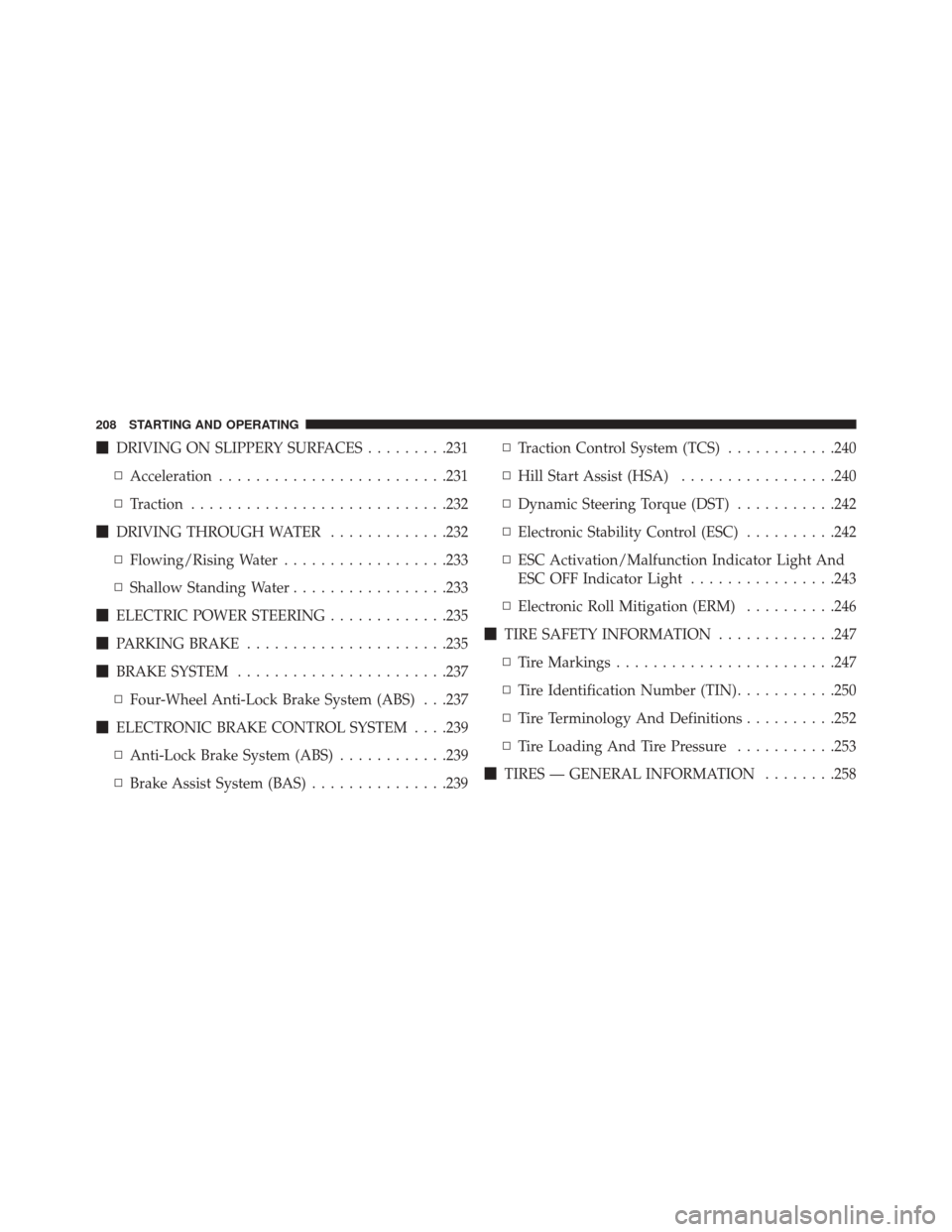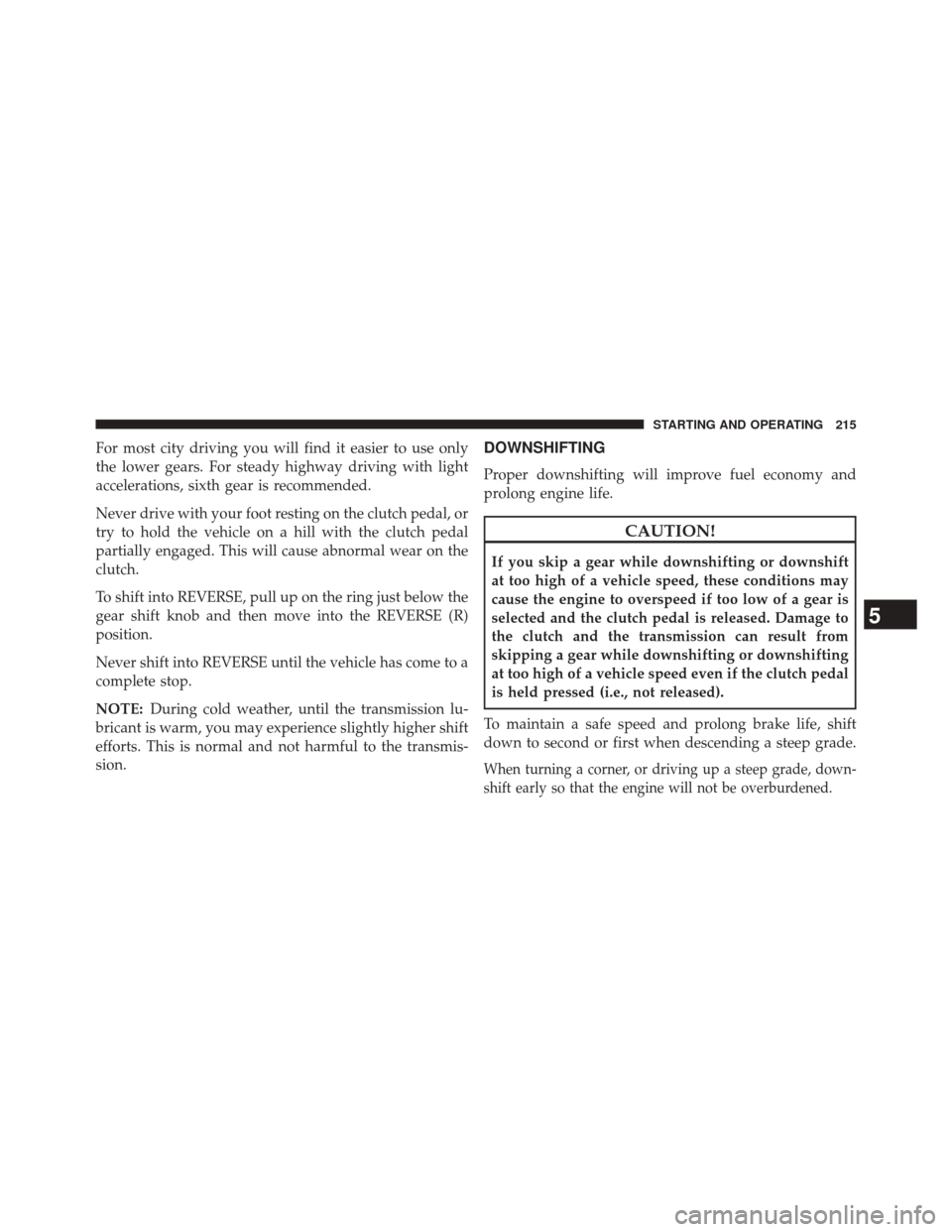Page 169 of 409

27. Electronic Throttle Control (ETC) LightThis light informs you of a problem with the
Electronic Throttle Control (ETC) system. If a
problem is detected, the light will come on
while the engine is running. Cycle the ignition
key when the vehicle has completely stopped and the
shift lever is placed in the NEUTRAL position. The light
should turn off. If the light remains lit with the engine
running, your vehicle will usually be drivable; however,
see an authorized dealer for service as soon as possible. If
the light is flashing when the engine is running, imme-
diate service is required and you may experience reduced
performance, an elevated/rough idle or engine stall and
your vehicle may require towing. The light will come on
when the ignition is first turned to ON/RUN and remain
on briefly as a bulb check. If the light does not come on
during starting, have the system checked by an autho-
rized dealer. 28. Anti-Lock Brake (ABS) Light
This light monitors the Anti-Lock Brake System
(ABS). The light will turn on when the ignition
switch is turned to the ON/RUN position and
may stay on for as long as four seconds.
If the ABS light remains on or turns on while driving, it
indicates that the Anti-Lock portion of the brake system
is not functioning and that service is required. However,
the conventional brake system will continue to operate
normally if the BRAKE warning light is not on.
If the ABS light is on, the brake system should be serviced
as soon as possible to restore the benefits of Anti-Lock
brakes. If the ABS light does not turn on when the
ignition switch is turned to the ON/RUN position, have
the light inspected by an authorized dealer.
4
UNDERSTANDING YOUR INSTRUMENT PANEL 167
Page 184 of 409

Daytime Running Lamps (DRL)
This function may be used to activate / deactivate the
Daytime Running Lamps.
Proceed as follows to switch this function on or off:
1. Briefly press theMENUbutton to display the three
sub-menus.
2. Briefly press the MENUbutton. “On” or “Off” will
flash on the display (according to previous setting).
3. Press the UP
or DOWNbutton for setting.
4. Briefly press the MENUbutton to go back to the menu
screen, or press and hold the button (approximately
one second) to go back to the main screen without
storing the settings.
Hill Start Assist
This function is used when starting a vehicle from a stop
on a hill. Hill Start Assist maintains the same level of
brake pressure the driver applied for a short period of
time after the foot has been removed from the brake
pedal.
Proceed as follows to switch this function on or off:
1. Briefly press the MENUbutton. “On” or “Off” will
flash on the display (according to previous setting).
2. Press the UP
or DOWNbutton for setting.
3. Briefly press the MENUbutton to go back to the menu
screen, or press and hold the button (approximately
one second) to go back to the main screen without
storing the settings.
182 UNDERSTANDING YOUR INSTRUMENT PANEL
Page 209 of 409
STARTING AND OPERATING
CONTENTS
�STARTING PROCEDURES ................211
▫ Manual Transmission — If Equipped .......211
▫ Automatic Transmission — If Equipped .....211
▫ Normal Starting .......................211
▫ Cold Weather Operation ................212
▫ Extended Park Starting ..................212
▫ If Engine Fails To Start .................213
▫ After Starting ....................... .213
▫ Turbo Charger “Cool Down” .............213�MANUAL TRANSMISSION — IF EQUIPPED . . .214
▫
DOWNSHIFTING .....................215
� AUTOMATIC TRANSMISSION —
IF EQUIPPED ........................ .216
▫ Key Ignition Park Interlock ...............218
▫ Brake/Transmission Shift Interlock System . . .218
▫ Six-Speed Euro Twin Clutch Transmission —
If Equipped ........................ .218
� AUTOSTICK® — IF EQUIPPED ............230
▫ Operation .......................... .230
5
Page 210 of 409

�DRIVING ON SLIPPERY SURFACES .........231
▫ Acceleration ........................ .231
▫ Traction ........................... .232
� DRIVING THROUGH WATER .............232
▫ Flowing/Rising Water ..................233
▫ Shallow Standing Water .................233
� ELECTRIC POWER STEERING .............235
� PARKING BRAKE ..................... .235
� BRAKE SYSTEM ...................... .237
▫ Four-Wheel Anti-Lock Brake System (ABS) . . .237
� ELECTRONIC BRAKE CONTROL SYSTEM . . . .239
▫ Anti-Lock Brake System (ABS) ............239
▫ Brake Assist System (BAS) ...............239 ▫
Traction Control System (TCS) ............240
▫ Hill Start Assist (HSA) .................240
▫ Dynamic Steering Torque (DST) ...........242
▫ Electronic Stability Control (ESC) ..........242
▫ ESC Activation/Malfunction Indicator Light And
ESC OFF Indicator Light ................243
▫ Electronic Roll Mitigation (ERM) ..........246
� TIRE SAFETY INFORMATION .............247
▫ Tire Markings ....................... .247
▫ Tire Identification Number (TIN) ...........250
▫ Tire Terminology And Definitions ..........252
▫ Tire Loading And Tire Pressure ...........253
� TIRES — GENERAL INFORMATION ........258
208 STARTING AND OPERATING
Page 213 of 409

STARTING PROCEDURES
Before starting your vehicle, adjust your seat, adjust both
inside and outside mirrors, and fasten your seat belts.
WARNING!
•Never leave children alone in a vehicle, or with
access to an unlocked vehicle.
• Allowing children to be in a vehicle unattended is
dangerous for a number of reasons. A child or
others could be seriously or fatally injured. Chil-
dren should be warned not to touch the parking
brake, brake pedal or the shift lever.
• Do not leave the Key Fob in or near the vehicle (or
in a location accessible to children). A child could
operate power windows, other controls, or move
the vehicle.
Manual Transmission — If Equipped
Apply the parking brake, place the shift lever in NEU-
TRAL, and press the clutch pedal before starting the
vehicle. This vehicle is equipped with a clutch interlock-
ing ignition system. It will not start unless the clutch
pedal is pressed to the floor.
Automatic Transmission — If Equipped
The shift lever must be in the PARK or NEUTRAL
position before you can start the engine. Depress the
brake pedal before shifting to any driving gear.
NOTE: You must press the brake pedal before shifting
out of PARK.
Normal Starting
NOTE: Normal starting of either a cold or a warm
engine is obtained without pumping or pressing the
accelerator pedal.
5
STARTING AND OPERATING 211
Page 216 of 409
on the type of driving and the amount of cargo, the pump
will run for up to 10 minutes after the engine has been
shut off to circulate coolant through the turbocharger.
Although the pump is rubber-mounted for quiet opera-
tion, it is normal to hear it running during this time.
MANUAL TRANSMISSION — IF EQUIPPED
WARNING!
You or others could be injured if you leave the
vehicle unattended without having the parking
brake fully applied. The parking brake should al-
ways be applied when the driver is not in the vehicle,
especially on an incline.
Fully press the clutch pedal before you shift gears. As you
release the clutch pedal, lightly press the accelerator
pedal. Use each gear in numerical order, do not skip a gear. Be
sure the transmission is in first gear, (not third), when
starting from a standing position. Damage to the clutch
can result from starting in third.
Shift Pattern (Six-Speed)
214 STARTING AND OPERATING
Page 217 of 409

For most city driving you will find it easier to use only
the lower gears. For steady highway driving with light
accelerations, sixth gear is recommended.
Never drive with your foot resting on the clutch pedal, or
try to hold the vehicle on a hill with the clutch pedal
partially engaged. This will cause abnormal wear on the
clutch.
To shift into REVERSE, pull up on the ring just below the
gear shift knob and then move into the REVERSE (R)
position.
Never shift into REVERSE until the vehicle has come to a
complete stop.
NOTE:During cold weather, until the transmission lu-
bricant is warm, you may experience slightly higher shift
efforts. This is normal and not harmful to the transmis-
sion.DOWNSHIFTING
Proper downshifting will improve fuel economy and
prolong engine life.
CAUTION!
If you skip a gear while downshifting or downshift
at too high of a vehicle speed, these conditions may
cause the engine to overspeed if too low of a gear is
selected and the clutch pedal is released. Damage to
the clutch and the transmission can result from
skipping a gear while downshifting or downshifting
at too high of a vehicle speed even if the clutch pedal
is held pressed (i.e., not released).
To maintain a safe speed and prolong brake life, shift
down to second or first when descending a steep grade.
When turning a corner, or driving up a steep grade, down-
shift early so that the engine will not be overburdened.
5
STARTING AND OPERATING 215
Page 218 of 409

AUTOMATIC TRANSMISSION — IF EQUIPPED
CAUTION!
Damage to the transmission may occur if the follow-
ing precautions are not observed:
•Shift into PARK only after the vehicle has come to
a complete stop.
• Shift into or out of REVERSE only after the vehicle
has come to a complete stop and the engine is at
idle speed.
• Do not shift between PARK, REVERSE, NEU-
TRAL, or DRIVE when the engine is above idle
speed.
• Before shifting into any gear, make sure your foot
is firmly pressing the brake pedal.
NOTE: You must press and hold the brake pedal while
shifting out of PARK.
WARNING!
• It is dangerous to shift out of PARK or NEUTRAL
if the engine speed is higher than idle speed. If
your foot is not firmly pressing the brake pedal, the
vehicle could accelerate quickly forward or in re-
verse. You could lose control of the vehicle and hit
someone or something. Only shift into gear when
the engine is idling normally and your foot is
firmly pressing the brake pedal.
(Continued)
216 STARTING AND OPERATING